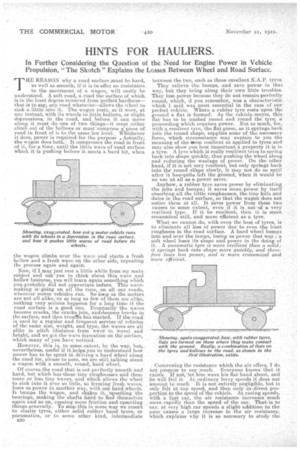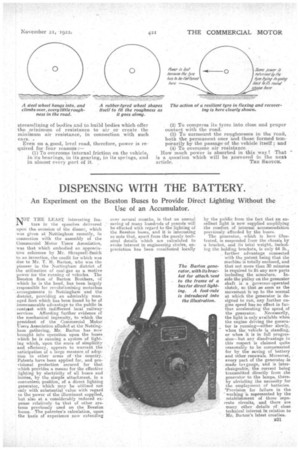HINTS FOR HAULIERS.
Page 14

Page 15

If you've noticed an error in this article please click here to report it so we can fix it.
In Further Considering the Question of the Need for Engine Power in Vehicle Propulsion, "The Skotch" Explains the Losses Between Wheel and Road Surface.
THE REASON why a road surface must-be hard, as well as smooth, if it is to offer no resistance to the movement of a wagon, will easily be understood. A soft road, a road the surface of which is in the least degree removed from perfect hardness— that is to say, any road whatever—allows the wheel to sink a little into it. The wagonrests., as it were, at any instant, with its wneels in little hollows, or slight depressions, in the road, and before it can move along it .must do one of two things—it must either climb out of the hollows or must'eomprees apiece of road in front of it to the same-low level.. Whichever it does, power is required for the purpose ,, Actually; the wagon does both:. It compresses the road in front of it, for -a time, until the little wave of road surface which it-is pushing before it meets a hard bit, when the wagon climbs over the wave and starts a fresh hollow and a fresh wave on the other side, repeating the process again and again.
Now, if I may just rest a little while from my main subject and ask'you to think about this wave and hollow business, you will learn again something which you: probably did not appreciate before. This wave making is,going on all the time, on all our roads, wherever motor vehicles run. Solong as the motors are not all alike,-or so long as few of them are alike, nothing very serious happens for a long time if the road surface is a good one. Eventually the waves become cracks, the cracks: join, andebecome breaks in the surface, and then troullle has started. If the road is used by a regular and frequent service of vehicles of the same size, weight, and type, the Waves. are all alike in pitch (distance from s.vave` to 'wave) and height, and we get the wave formation on the surface, which many ofyou have notic'ed: However, this is; to some-extent, by the. way, huts, nevertheless, useful if it,helps.you to understand how. power has to be spent in driving a hard wheel, along the road for, please to note, we are still talking about a wagon with a smooth, round; hard wheel.
Of course the road that is not perfectly smooth and hard, but which has these tiny roughnesses and these more or less tiny waves, and which allows the wheel to sink into it ever so little, so forming fresh Waves.; _ loses us power in another way, with Our hard. wheels. it bumps the wagon, and shakes it,. npSetting. the bearings making the shafts -hard to find theruselves again arid so on, causing more frictionand upsetting things generally. To stop. this in some way we resort to. elastic tyres, either solid rubber band tyres, or pneumatics, or to some other kind, intermediate
B30 between the two, such as those excellent N.A.P. tyres, They relieve the bumps, and save power in that way, but they bring along their own little troubles. They lose power because they do not remain perfectly round, which, if you remember, was a characteristic which I said was most essential in the case of our, perfect vehicle. Where a rubber tyre rests upon the ground a flat is formed. As the vehicle moyes, this fiat has to be pushed round and round the tyre, a proceeding-which requiees power. Not so much, for,.
with -a resilient tyre, the .flat piece, as it springs back into the round shape, supplies some of the necessary
force, which eircumstanee may explain to you the meaning of the term_ resilient as applied to tyres and may -also show you hoysi important a property it is in a tyre. A tyre which is really resilient tries to spring back into shape quickly, thus pushing the wheel along and reducing the wastage of power. On the other hand, if it is not very resilient, but only springs back into the round slfape slowly, it may not do so until after 'it hastquite left the ground, when it would be no use at all as a power saver.
Anyhow, a rubber tyre saves power by eliminating the jolts and bumps; it saves more power by 'itself absorbing„all the little roughnesses, the tiny hills and
dales in the road surface,/ so that the wagon does not notice them at all. It saves power from these two causes to some extent, even if it is . notof a very resilient type. If it be resilient, then it is more economical still, a-nd mom efficient as a tyre.
What we cannot do, with even the best c,f tyres, is to eliminate all loss of power due to even the least roughness in the road surface. A hard wheel bumps into and over the-lumps, losing us power that way ; soft wheel loses its shape and power in the doing of it. Apneumatic tyre 1,5 more resilient than a solid; it springs back into shape more quickly,• and therefore lOses less power, and is more economical and More efficient.
. Connerning the resistance which the air offers, I do not'propose to say much. Everyone knows that it exists.' If not,'!et him wave his flat-hand about, and he -will feel, it. At ordinary lorry speeds if does not 'amount. to .much. It is not entirely negligible, but is only felt at .top speed, and then only in,direct, pro:portion-0 the speed of the vehicle. At racing speeds, with 'a fast car, the air resistance increases much -more-rapidly than the speed of. the car. That:is to say, at very high car speeds a slight addition to the pace causes a large increase in the air resistance, which explains why it is so necessary to study the
streamlining of bodies and to build bodies which offer the minimum of resistance to air or create the minimum air resistance, in connection with such cars, .
Even on a. good, level road, therefore, power is required for four reasons:— (1)1'o overcome internal friction on the vehicle, in its bearings, in its gearing, in its springs, and in almost every part of it. (2) To compress its tyres into close and proper contact with the road, (3) To surmount the roughnesses in the road, both the permanent ones and those formed tempOrarily by the passage of the vehicle itself ; and (4) To overcome air resistance. How much power is absorbed in this way ? That is a question which will be answered in the next
article. THE SHOTCH.






























